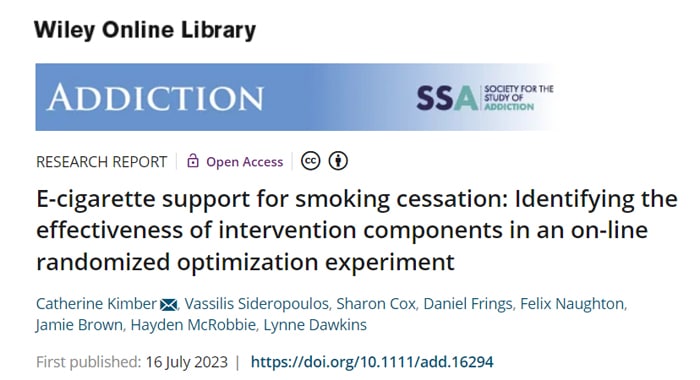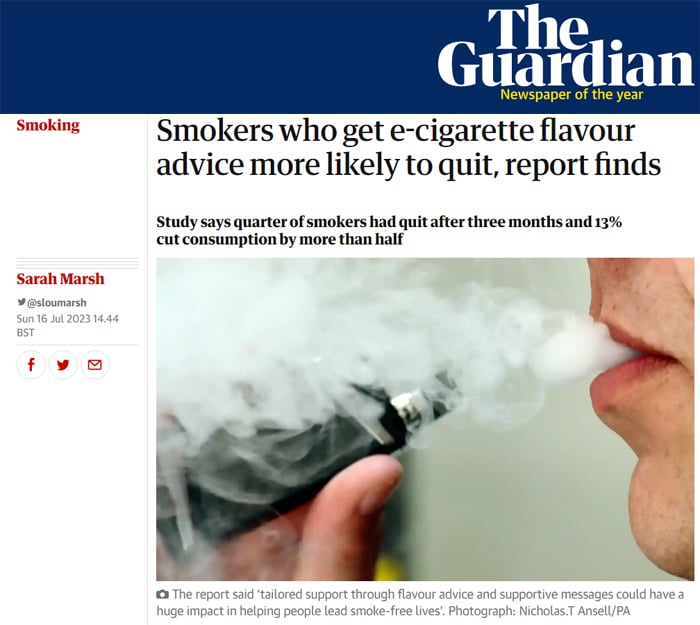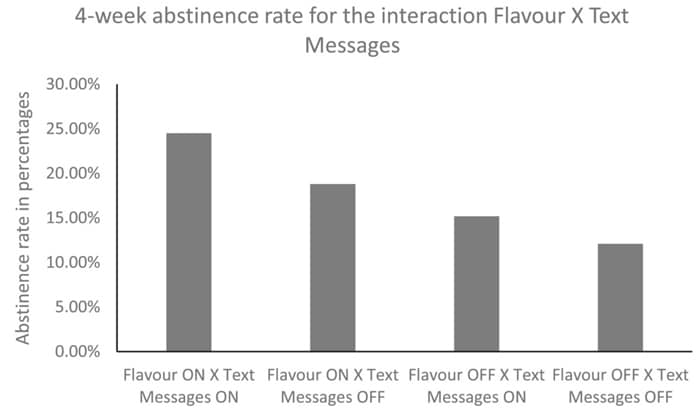OK, I know I am a bit late reporting on this one!
An excellent study was published on 16th July 2023 titled “E-cigarette support for smoking cessation: Identifying the effectiveness of intervention components in an on-line randomized optimization experiment”
Also this was picked up by the Guardian newspaper.
Switching from smoking to vaping can be intimidating, all the new gadgets and terminology. Even where to start with e-liquids and equipment can be daunting.
Not to mention all of the negative publicity about vaping which may make people reluctant to give it a bash.
A lot of people get great advice if they pop in a vape shop and have a chat about their options. However with a large amount of vaping gear being purchased online, some people are not always getting the advice they need to get the best out of vaping.
Introduction
This study appears to be based in Great Britain with funding and support from the Medical Research Council (Swindon, UK) and Cancer Research UK.
I am loving the study introduction, some of the highlights include…
“In England, e-cigarettes (EC) have become the most popular methods of quitting over the last 10 years, supporting approximately 35% of all attempts. There is increasing evidence for their efficacy in promoting quitting over more conventional cessation aids; between 8 to 12% of those making a quit attempt using a nicotine EC typically achieve abstinence at 6 months, compared with 6% of those using nicotine replacement therapy (NRT), or 4% of those using behavioural support only or no support”
“In stop smoking services between 2020 and 2021, approximately 65% of quit attempts involving EC (alone or combined with medication), were successful at 4-week follow-up compared with 59% of attempts not involving EC”
“Given their potential effectiveness and the harm reduction benefits if people fully switch, a clearer understanding of what types of support can help more smokers to fully transition to e cigarettes is warranted.”
“Between 13 and 19% of smokers report purchasing on-line, with indication of future growth, and EC starter kits appear to be the most frequently purchased product. However, little guidance or support on what or how to use is currently provided”
The study also highlighted why most smokers would appreciate advice on choice of vaping equipment…
“First, the wide range of devices available can be confusing, with ‘too much choice’ or difficulty finding the right combination of EC device, nicotine strength and flavour as barriers to EC initiation. Evidence suggests that second- and third-generation devices can outperform early ‘cigalike’ and disposable models, but such devices are sometimes described as too ‘bulky’ or ‘scary’, which may act as a deterrent”
“Secondly, lack of satisfaction from EC use appears to be the chief reason for discontinuing use. In a 2021 survey in Great Britain, 79% of smokers who had tried but discontinued EC use reported vaping as less satisfying than smoking. There is likely to be a variety of reasons for inadequate satisfaction, although insufficient nicotine delivery and strength may play a role. Given that EC nicotine concentration is associated with improvements in smoking cessation, advice to choose a nicotine strength that adequately satisfies tobacco craving, based on nicotine dependency, may help to support sustained use.”
“Thirdly, flavour is a commonly cited reason for EC use and is known to enhance their appeal, as well as promoting cessation, although whether specific flavours or advice on which flavour to select increase the effectiveness of EC for smoking cessation is unknown. Although many vape shops offer support and assistance around product choice and e-liquid nicotine strength and flavour, for some this can feel overwhelming, and this support is usually absent when purchasing on-line. Smokers purchasing on-line may therefore benefit from simple tailored advice on which device, nicotine strength and flavour to choose in order to help them transition more easily and fully to EC.”
“Fourthly, a key barrier to initiating or sustaining EC use is concern over safety. A growing number of people in England and elsewhere in the world consider EC to be equally or more harmful than smoking and safety concerns are frequently cited among smokers as reasons for not trying or discontinuing EC. Providing information around the relative harms of EC compared with smoking may help to correct such misperceptions and promote use to support smoking cessation. In support of this, a recent experimental study has shown that a nicotine fact sheet can help to correct EC risk perceptions and messages conveying reduced risk information around EC have been associated with lower odds of smoking.”
“Finally, difficulties with starting using an EC have been reported as challenging for some smokers; therefore, more support in the early days of transitioning may be needed. To address this, we have developed a set of text messages designed to assist a successful transition to vaping by providing ongoing technical assistance and behavioural support. Mobile phone text messages have been shown to increase long-term abstinence among smokers by approximately 70% and is recommended as a cost-effective option by the World Health Organization (WHO).”
As you can see, this is an excellent study, addressing concerns smokers might have about starting vaping.
I really love the direction they are taking!
Study Methods
The study examines which online methods proved to be the most effective in helping smokers transition to vaping.
The methods investigated were…
- Offering tailored device selection advice
- Tailored e-liquid nicotine strength advice
- Tailored e-liquid flavour advice
- Brief information on relative harms
- Text message (SMS) support.
A combination or single method were used on each participant.
A total of 1214 people took part and were recruited via Social Media and data was collected online between April and October 2020.
Here is what happened for those taking part…
“From the study webpage, participants were directed to the Qualtrics baseline survey to check eligibility. Eligible participants were invited to provide electronic informed consent before completing the baseline survey. After completing baseline measures, participants were randomly allocated to one of the 32 conditions. Conditions were randomized in Qualtrics using the Randomizer function, each generated an equal number of times.
Personalized recommendations regarding the interventions allocated were displayed at the end of the baseline survey and sent via e-mail together with detailed instructions and a direct link to an on-line EC store (Totally Wicked) with a unique voucher code, purchased by the study team, to receive a free EC kit. Upon clicking on the study link, participants landed on a study-specific page on the EC store. Although it was not possible to ensure that participants selected the recommended products, choice was made limited so that only the recommended products offered in this study were visible on the EC store landing page.
After 12 weeks, participants were e-mailed with a link to complete the follow-up questionnaire, which asked about abstinence and cigarette smoking (cigarettes smoked per day in the last 7 days), EC use, adherence to the advice given and helpfulness of the different intervention components. Those who completed the follow-up questionnaire were provided with a £10 Amazon voucher. Those who did not complete the follow-up survey after five e mail reminders were e-mailed and texted one-single question: ‘Have you smoked at all in the last 4 weeks’ to maximize data for the primary outcome.”
The supporting information is downloadable here which includes the survey used for this study.
According to the answers given in the survey, one of 3 vape devices (Vape Pen, Pod Kit or Tank/Mod combo) were recommended and nicotine strength / flavour advice was given depending on the participants preference. A voucher code was also given to assist with purchase of the recommended kit / e-liquid.
12 weeks after taking the initial survey the respondents were sent another survey questioning their smoking / vaping status and feedback on whether the advice was helpful.
Study Findings
At the second (12 week) follow up, 44% (529) of the participants completed the survey in full.
Another 107 responded to the email / text enquiry.
Therefore a total of 52% (636 of 1214) provided data for analysis.
Smoking Abstinence
The overall rate for abstaining from smoking was 19%. An additional 13% said they had reduced their smoking by more than 50%.
The most successful method was the combination of Flavour advice and Text messages.
When advice on flavours and text messages were combined there were more smokers reporting abstinence from smoking over the previous 4 weeks (25%). Compare this with those who only received advice on flavours (19%) or text message alone (15%). Those who received neither had smoking abstinence rates of only 12%.
Conclusion
I quote…
“our findings suggest that tailored advice on flavour and text message support is a promising intervention combination to promote smoking cessation, and warrants further evaluation in a RCT (Randomised Controlled Trial) with biochemically verified abstinence and longer-term outcomes. These findings highlight the importance of evaluating individual intervention components (main effects and interactions) before embarking on a RCT to maximize the chances of developing an effective and cost-effective intervention package. Nevertheless, future research is needed to test whether this interaction is replicable, especially as it was not predicted a priori, and data were collected during an atypical period.”
Congratulations to the authors on a brilliant study, actually examining what is putting smokers off swapping to vaping.
I agree with all the obstacles pointed out and love how the study aimed to address or aid smokers.
Any measures for helping smokers transition to vaping will be beneficial to public health!
Amazing work!
We Can Help!
Please remember all of the EcigClick team are on hand to help with any queries you might have. Just comment on any of our articles or contact us on social media…
Plus we have many guides to help get you started and find the best equipment!
In particular take a look at our Best Starter Kits and Best Pod kits for hardware advice.
Related Tweets
Ah ha! Finally, this study led by @LynneDawkins and @cat_kimber, we discussed way back when! And here we have the results, finally out… So pleased to be part of this. Good research takes time. https://t.co/CeiFLxznI8
— Sharon Cox (@Sharon_ACox) July 16, 2023
Smokers who get e-cigarette flavour advice more likely to quit, report finds https://t.co/BYY9KV5Kue #vaping #ukvia
— UKVIA (@Vaping_Industry) July 16, 2023
At the recent @CommonsHealth oral evidence hearing, one MP asked for evidence to support flavours being useful for smoking cessation. Here is a new study on this subject, by @LynneDawkins @cat_kimber https://t.co/LsjLwt6oti
— NNAlliance (@NNAlliance) July 17, 2023
“The simplicity of tailored support through flavour advice and supportive messages could have a huge impact in helping people lead smoke-free lives.”https://t.co/zLvWnbV5vc
— European Tobacco Harm Reduction Advocates (@europethra) July 16, 2023
The role of #vape #flavours in #quitting #smoking.
Smokers who get e-cigarette flavour advice more likely to quit, report finds | Smoking | The Guardian https://t.co/9z58MHTufg
— Martin Dockrell (@SwitchFinder) July 16, 2023
“Smokers who get help picking the flavor of e-cigarette they will use and receive supportive text messages are much more likely to quit,
After 3 months, 25% had quit and an additional 13% reduced their cigarette consumption by more than half.”https://t.co/KIaDeEpMjB— Lance Churchill (@LanceChurchill) July 17, 2023









